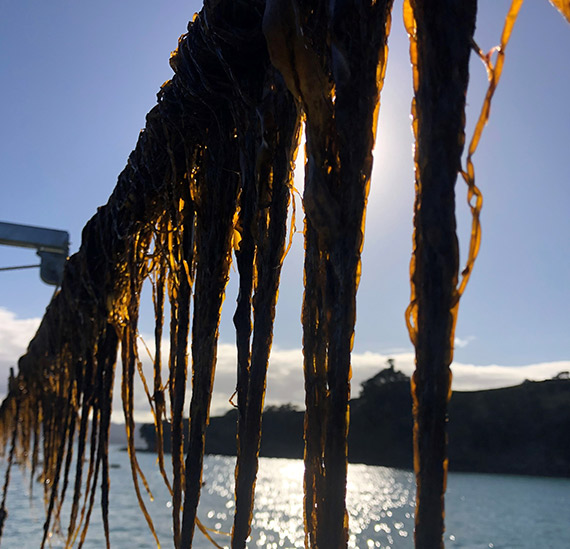
WHY SEAWEED?
We believe we have something special here in Aotearoa New Zealand – a vast, unique ocean environment which supports incredible biodiversity. We have a large number of seaweed species, many of which are unique to our shores.
Seaweed has a growing number of applications across different industries and as the world begins to really understand the various benefits seaweeds have to offer, Aotearoa New Zealand is well placed to fill those needs.
We can grow seaweeds, in clean water, with a light touch on the environment, we are innovators, and guardians of our marine environment.
Join us in our mission to build a sustainable high-value industry for the future – one that is good for people and good for our planet.
Our Large, Clean and Unique Ocean
Aotearoa New Zealand has one of the most unique marine environments on the planet ~ a hotspot for biodiversity ~ with a wide variety of aquatic plants and animals. A global study in 2008 found that New Zealand ranked the highest in the world for our proportion of endemic species, due to the isolation of Australia and New Zealand, which separated from other land masses about 83 million years ago.
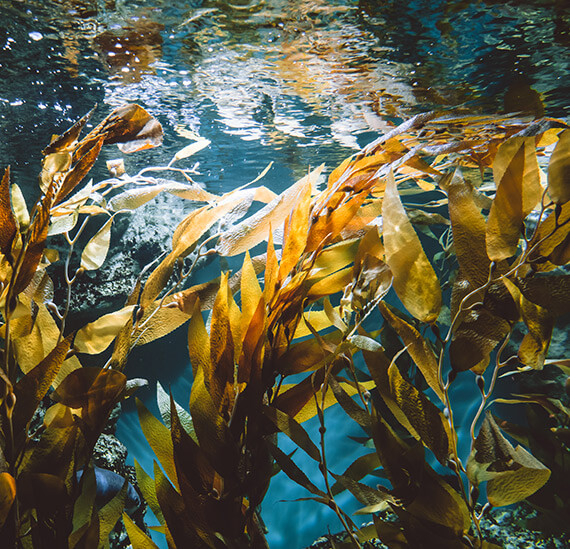
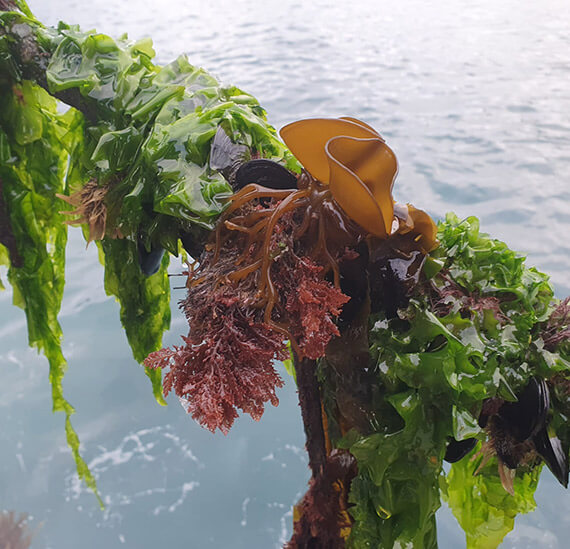
New Zealand has over 1,000 species of seaweeds!
Over the length of New Zealand there is a 6 degree change in ocean temperature ~ a subtropical Northland and the subantarctic Auckland Islands in the far south. Different currents bring warm tropical waters in the north and cold deep-ocean waters in the south. The mixing of these currents creates unique zones which support a large range of life. We have over 50 habitat types in our coastal regions alone, each supporting different species. It’s been estimated that there could be over 50,000 marine species left to be discovered.
We also have many deep underwater canyons, such as the Kaikōura Canyon, which carry nutrient-rich water up from the deep sea, supporting many kinds of marine life. Our wider region, Oceania, has three out of the four deepest ocean trenches in the world. The Kermadec Trench is the second deepest ocean trench in the world. At 10,047 meters, it is much deeper than Mount Everest is tall.
Our Ocean is 15 times the size of our land!
Our Exclusive Economic Zone (EEZ) is 4.2 million square kilometers, the fifth largest in the world, and about 15 times our land mass size! An EEZ is the sea area over which a nation has special rights to explore and gather resources. Ours stretches from the edge of the coast to 200 nautical miles offshore, and includes the wider continental shelf of Zealandia.
We have roughly the same known species diversity as the entire European marine area, which is almost six times larger.
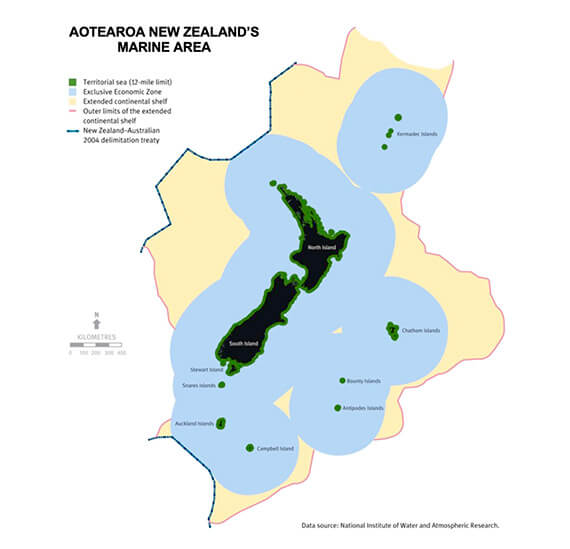
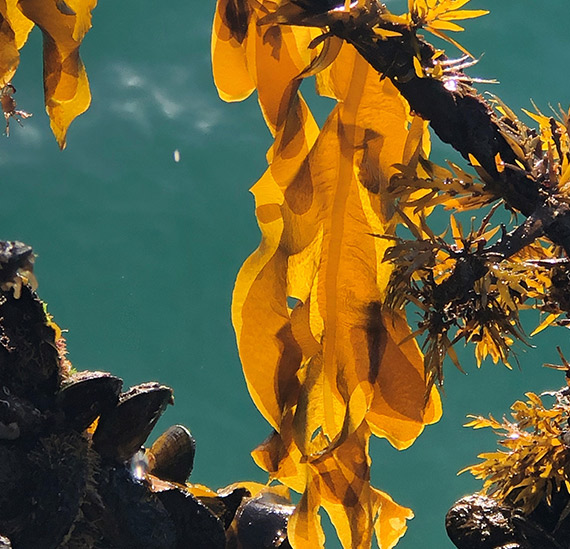
Aotearoa New Zealand’s coastal environment is well suited to seaweed aquaculture.
New Zealand’s marine environment is already home to an innovative and thriving blue economy. Seaweed aquaculture presents a new opportunity to grow in this space, but it is anything but business as usual. Farming in the ocean has unique challenges and sustainable growth of seaweed aquaculture will require investment in new aquaculture technologies, hatcheries, processing facilities, and development of supply chains and markets. New Zealand is naturally well positioned to advance this new industry with our existing investment in aquaculture infrastructure. Seaweed aquaculture is the only scalable and nature positive option to meet the global demand for New Zealand seaweed products while safeguarding our precious marine environment.
WHY IS SEAWEED IMPORTANT?
Many of us have not considered seaweed in much detail but it provides crucial ecological and ecosystem services in coastal ecosystems. Including the following (adapted from Beamont et al. 2007):
Food & Medicine
Seaweed is a nutrient dense, low fat, plant based protein source. Traditional medicines often included seaweeds as a natural source of essential elements such as iodine, iron, manganese, copper and zinc.
Habitat provision for living marine organisms
Seaweeds are primary producers in our coastal ecosystems, providing food and shelter for millions of organisms. Beds of seaweed also provide a safe place for fish and shellfish to breed.
Spiritual and physical connection
The traditional practices of seaweed harvesting for kai (food) and rongoā Māori (medicine) have for centuries provided an important spiritual and physical connection to the moana for Māori. Our seaweeds, and the coastal ecosystems they help sustain, now also provide important ecosystem services that support tourism, employment, and recreational fishing.
Bioremediation
Seaweeds help to remove excess nutrients in our coastal ecosystems through storage, burial and recycling.
Gas and climate regulation
Seaweeds play an important role in balancing and maintaining the chemical composition of our coastal waters by recycling carbon dioxide and assimilating excess nutrients.
Coastal protection
Seaweed beds in the coastal zone provide a natural defense against inundation and erosion from waves, storms and sea level rise.
Colours of Seaweed
All seaweeds contain chlorophyll and photosynthesize. They are broadly categorized into three groups depending on their pigment:
Brown
seaweeds are medium to giant-sized – kelps are the largest. Visit Beautiful Browns to learn more.
Green
Green seaweeds are found between high- and low-water marks, where there is plenty of sunlight. A common species on New Zealand coasts is the edible sea lettuce (Ulva).
Red
Red seaweeds grow in water up to 25 metres deep. There are approximately 550 species of red seaweeds in New Zealand.
Key species characteristics and opportunities for Aotearoa New Zealand
The second report from Sustainable Seas identifies the following seaweed species as key opportunities for Aotearoa New Zealand:
Karengo (Nori)
A group of red seaweeds that are found intertidally, and are a taonga to Māori. They are a traditional food source, and are high in protein as well as omega-3 fatty acids and vitamin B12. They are related to species consumed elsewhere (e.g., nori), and techniques for their cultivation are therefore likely to be similar.
There is an opportunity to produce unique Aotearoa foods with health benefits from them.
Asparagopsis
A genus of red seaweeds. The main species that occurs in Aotearoa New Zealand, Asparagopsis armata, has traditionally been cultivated in France and Ireland for use in cosmetic products. Interest in cultivation of Asparagopsis spp. has increased markedly in the last few years following discovery of their ability to reduce methane emissions from ruminant livestock when used as a feed supplement.
Agarophytes
Typically used for food and agar. There are established cultivation methods in Chile and Asia for some species that are also found here. We may be able to adapt overseas cultivation methods to suit other domestic species, but it may be difficult to compete with other agar-producing countries.
Lamanarians
Lamanarian kelps are subtidal algae that are used to produce a range of products including fertiliser and food domestically and overseas. Bladder kelp (Macrocystis pyrifera) has been farmed on a small scale in the Marlborough Sounds for several decades. Undaria pinnatifida (Wakame), an invasive kelp in Aotearoa New Zealand that arrived in New Zealand over 40 years ago, is now found throughout mainland New Zealand and naturally settles on to mussel lines and other coastal structures where it is harvested for use in natural biostimulants. Internationally, Undaria is cultivated at large scales on suspended long line systems similar to those used to farm mussels in Aotearoa New Zealand. Other native laminarian algae like Ecklonia radiata and Lessonia variegata may also be well suited to long line cultivation.
Fucoids
Fucoid algae have simple life cycles. Internationally they are sold as food and food ingredients. Although domestic species have not been farmed, there is widespread cultivation of related fucoid algae globally that would provide a good starting point for innovative cultivation systems in Aotearoa New Zealand.
Green algae
Typically grown for bioremediation in land-based systems overseas and can be used to produce products such as biostimulants and fertilisers. These techniques could be applied to species found in Aotearoa New Zealand.
Other useful reference material can be found on Niwa’s website
Secret Life of Seaweed
Seaweed – Its Spectacular
What are you eating? NZ scientists reclassify nori – the seaweed used to make sushi
Beautiful Browns
‘Aotearoa New Zealand has a wealth of diversity amongst the seaweeds growing along our coastlines. Māori have a special whakapapa relationship with native flora and fauna, including our seaweed species. Māori kaitiaki rights and interests in taonga seaweed species and associated mātauranga is important to acknowledge and respect.’
Extract from ‘Sustainable Seas Report: Species characteristics and Te Tiriti o Waitangi considerations’